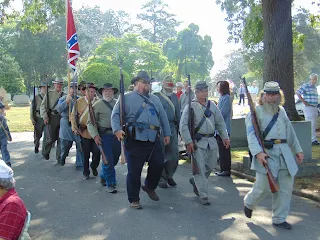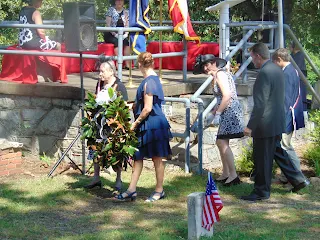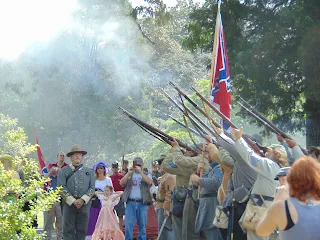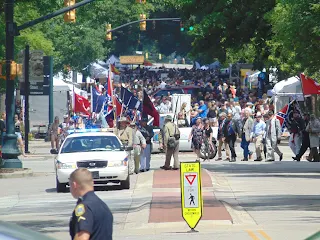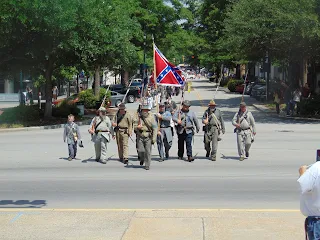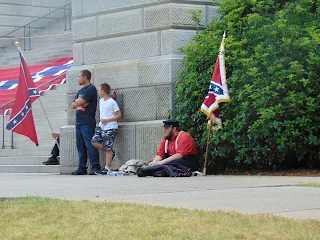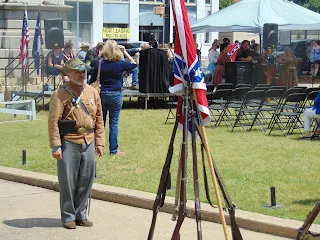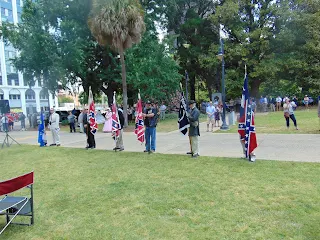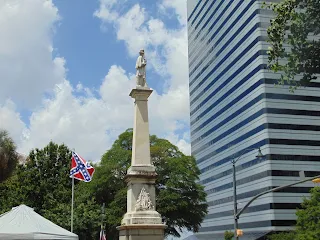Today is Memorial Day, a federal holiday in the United States for remembering and honoring people who have died while serving in the United States Armed Forces.
For some the unofficial start of the summer vacation season in the US and a time to gather with family and friends for outdoor barbecues, pool parties, or sporting events. For many others it is a solemn time to visit cemeteries and war memorials and placed US flags and flowers on the graves of loved ones who fell in defense of our nation as members of our armed services.
Every year volunteers place US flags on the graves of soldiers buried in national cemeteries across the country. Thousands of large and smaller ceremonies honoring the honored dead take place on Memorial Day, as well as the weekend leading up to it.
Memorial Day (then called Decoration Day) was observed on May 30 from 1868 until 1971 when it was officially declared a federal holiday and moved to the last Monday of the month.
Probably the most interesting thing about the Memorial Day holiday is that it originated in the aftermath of the American Civil War because of the practice of honoring the Confederate dead.
Honoring The Dead
The practice of decorating soldiers' graves with flowers is an ancient custom. Soldiers' graves were decorated in the U.S. before and during the War Between the States. Several accounts exist of the war dead being honored during the war itself.
In May of 1862, women in Savannah, Georgia decorated Confederate soldiers' graves in spring after the flowers were in full bloom. The cemetery dedication at Gettysburg, Pennsylvania on Thursday, November 19, 1863 was a ceremony of commemoration at the graves of dead soldiers and the creation of one of the first national cemeteries.
On Monday, July 4, 1864, ladies decorated Union soldiers' graves in Boalsburg, Pennsylvania. On Monday, May 1, 1865, in Charleston, South Carolina, recently freed African-American slaves held a parade of 10,000 people to honor 257 dead Union Soldiers, whose remains they had reburied from a mass grave in a nearby prison camp. Many in attendance brought flowers to decorate the cemetery. On Saturday, May 5, 1866, a year after the war ended, the town of Waterloo, New York was decorated with flags at half mast, draped with evergreens and mourning black.
The most devastating war in American military history ended in 1865 with over 600,000 American soldiers on both sides dead (more recently calculated at an estimated 750,000), nearly 2% of the American population at the time. Burial and memorializing the fallen took on a new cultural significance.
Over a dozen US cities claim to be the place where US Memorial Day originated, though none of those mentioned were responsible for setting off what would be a widespread movement to honor the American dead.
That would change on Thursday, April 26, 1866 thanks to a very special group of Southern women from Georgia.
Confederate Memorial Day
The first significant widespread movement in America to honor the dead came due in large part to the efforts of the Ladies Memorial Association of Columbus, Georgia (see my previous blog post on this movement HERE).
Mary Ann Williams, the secretary of the Ladies Memorial Association (a forerunner of the United Daughters of the Confederacy) founded in Columbus during the winter of 1866, wrote a letter that was published in March and April of that year in more than two dozen newspapers across the country. The letter reported on the association’s resolution, one year after the end of the Civil War, to "beg the assistance of the Press and the Ladies throughout the South to aid us in our effort to set apart a certain day to be observed from the Potomac to the Rio Grande and be handed down through time a religious custom of the country to wreathe the graves of our martyred dead with flowers."
Lizzie Rutherford, another member of the association, was the first to suggest April 26th as the date for Memorial Day to coincide with the anniversary of Confederate General Joseph E. Johnston’s surrender to Union Major General William Sherman. Although this was 17 days after Confederate General Robert E. Lee surrendered to Union General Ulysses S. Grant at Appomattox, Virginia, the later April date was when the war in Georgia ended and was more conducive to having fresh flowers available to decorate the graves.
This even was widely reported in newspapers across the country. The Thursday, April 12, 1866 edition of The New York Times reported, "Preparations are being made at various points throughout the South to observe the 26th of April as an anniversary in honor of the rebel dead."
The ceremony took place on Thursday, April 26, 1866 in Columbus, Georgia's historic Linwood Cemetery where the graves of the dead were decorated with spring flowers. Since the former Confederate State was now under Union occupation, Reconstruction Era military laws prohibited the display of Confederate symbols, flags were not placed on the graves during those first memorial services until just after Reconstruction ended in 1876 ten years later.
Although Columbus, Georgia is credited with being the birthplace of what would be called Decoration Day (later Confederate Memorial Day), the first of these large scale observations actually took place a day earlier on Wednesday, April 25, 1866 in Columbus, Mississippi, due in large part to a printing error in the Memphis Appeal newspaper on the exact date. The Ladies Memorial Association there laid flowers on the graves of both the Union and Confederate dead in the city's historic Friendship Cemetery.
During the War, Columbus was a hospital town, and in many cases a burial site, for both Union and Confederate casualties of the Battle of Shiloh, brought in by the trainload. And it was in that Columbus where, at the initiation of four women who met in a house on North Fourth Street, a solemn procession was made to Friendship Cemetery on that late April day in 1866 -- four years after the battle.
As the story goes, one of the women spontaneously suggested that they decorate the graves of the Union as well as the Confederate dead, as each grave contained someone’s father, brother, or son.
A lawyer in Ithaca, New York, named Francis Miles Finch read about this reconciliatory gesture and wrote a poem about the ceremony in Columbus, "The Blue and the Gray" which The Atlantic Monthly published in 1867 and can be read HERE.
 |
| Decoration Day at Friendship Cemetery, Columbus, Mississippi. |
Today some Southern States still honor Confederate Memorial Day as a State holiday separate from US Memorial Day -- largely because Confederate soldiers, while they can be considered American Veterans, are not strictly US Veterans. A subtle distinction, but one that continues to be debated to this date, and which this blogger will discuss in a future blog post.
Decoration Day
 |
| The March of Time by Canadian painter Henry Sandham. Grand Army of the Republic (GAR) veterans on parade in Boston, Massachusetts in 1890. |
Two years later on Tuesday, May 5, 1868, Union General John Alexander Logan, who was the second commander in chief (1868-1871) of the Grand Army of the Republic (GAR), launched what would become the US Memorial Day holiday that is currently observed in the entire United States today.
According to the general's wife, Mary Logan, he emulated the practices of Confederate Memorial Day having observed one of these services in Petersburg, Virginia. She wrote that Logan said: "....it was not too late for the Union men of the nation to follow the example of the people of the South in perpetuating the memory of their friends who had died for the cause they thought just and right."
Logan issued a proclamation that commanded all GAR posts across the country to decorate Union graves with flowers on May 30th. He proclaimed: "The 30th of May, 1868, is designated for the purpose of strewing with flowers, or otherwise decorating the graves of comrades who died in defense of their country during the late rebellion, and whose bodies now lie in almost every city, village and hamlet churchyard in the land."
This date was chosen as the optimal date for flowers to be in bloom in the North, rather than for any particular event that occurred on that date. In 1868, memorial events were held in 183 cemeteries in 27 States. This doubled to 336 in 1869 as the Northern States quickly adopted the Southern practice.
The May 30 holiday was commonly known as both Decoration Day and Memorial Day.
In accordance with Logan’s proclamation, on Saturday, May 30, 1868 the first large observance of Decoration Day was held at Arlington National Cemetery, across the Potomac River from Washington, D.C. in Arlington County, Virginia.
The ceremonies centered around the mourning-draped veranda of the Arlington mansion, once the home of General Robert E. Lee. Various Washington officials, including General Ulysses S. Grant, presided over the ceremonies. After speeches, children from the Soldiers’ and Sailors’ Orphan Home and members of the GAR made their way through the cemetery, strewing flowers on both Union and Confederate graves, reciting prayers and singing hymns.
 |
| Decoration Day Postcard, circa 1880. |
Other than at Arlington, Decoration Day was mainly celebrated by Union veterans and family members of Union deceased soldiers. Most former Confederate States refused to recognize the date, and many even had their own Confederate Decoration Days. Confederate states honored their dead separately until after World War I, although some the women of the Ladies Memorial Association (and later the UDC) did voluntarily take the time to mark the graves of Union dead buried near Confederate soldiers.
Starting in 1868, the ceremonies and Memorial Day address at Gettysburg National Park became nationally known. By 1870, the remains of nearly 300,000 Union dead had been re-interred in 73 national cemeteries located near major battlefields mainly in the American Southland. In 1871, the State of Michigan made "Decoration Day" an official state holiday and by 1890, every northern state had followed suit.
The GAR officially adopted the name Memorial Day at their 1882 encampment.
A National Holiday
 |
| Union & World War I veterans honoring Memorial Day in Chicago, 1920. |
Memorial Day originally honored only those lost while fighting in the American Civil War. But during World War I (1914-1918) the United States found itself embroiled in another major conflict, and the holiday evolved to commemorate American military personnel who died in all wars.
In July 1913, veterans of the United States and Confederate armies gathered in Gettysburg to commemorate the fifty-year anniversary of the Civil War's bloodiest and most famous battle. Since the cemetery dedication at Gettysburg occurred on November 19th, the weekend closest to that day has been annually designated as their own local memorial day referred to as Remembrance Day. Parades of Union and Confederate reenactors march the streets of Gettysburg then gather to honor the dead at the national cemetery.
Memorial Day continued to be observed on May 30th for a hundred years until the United States Congress passed the Uniform Monday Holiday Act on Saturday, June 8, 1968 which formally established Memorial Day as the last Monday in May in order to create a three-day weekend for federal employees; the change went into effect in 1971. The same law also declared Memorial Day a federal holiday and took effect on Friday, January 1, 1971.
 |
| Each year
on US Memorial Day, there is a national ceremony at Arlington National
Cemetery where the US President places a wreath at the grave of the Unknown Soldier. |
On Memorial Day, the U.S. flag is
quickly raised to full-staff, and then slowly lowered to half-staff,
where it stays until noon. This is done in remembrance of all who have
given their lives in service of their country. At noon, the flag is
raised back to full-staff to show that their sacrifice was not in vain
and that we will continue to fight for liberty.
This Memorial Day, towns and cities across
America will host parades featuring military veterans
and service personnel. Festivals, parties, and barbecue have also become
synonymous with the holiday. Tradition has not escaped us though, as
many will visit national cemeteries and memorials to clean and decorate
the graves of the fallen and pay their respects to those that fought and
died for our country.
This blogger would also like to offer recognition to those fallen US soldiers who are very rarely talked about in regards to their service, those veterans who come home suffering the mental and emotional traumas of war, who struggle to regain their lives beyond the battlefield, and who often die in poverty from drug and alcohol abuse -- and sometimes usually homeless on the streets, or through mismanagement by the very government institutions that are supposed to look out for them. They may not have died in battle, but they die in a hell of war at home that is often times almost as bad.
May we continue to always honor the service and memories of these men and women who served our nation and gave the ultimate sacrifice to defend the freedoms we still currently enjoy.
 |
| You will never be forgotten! |

























